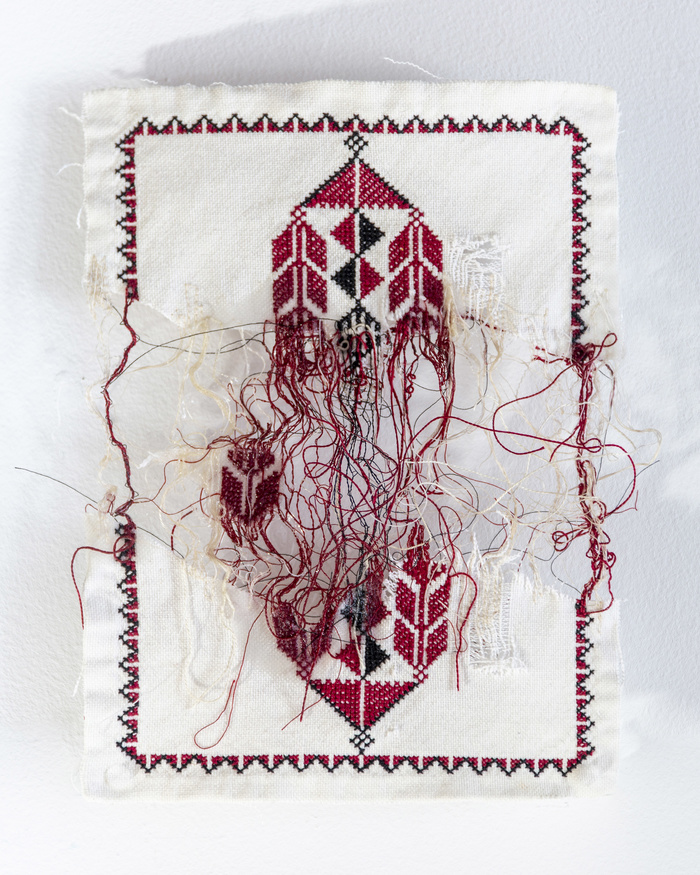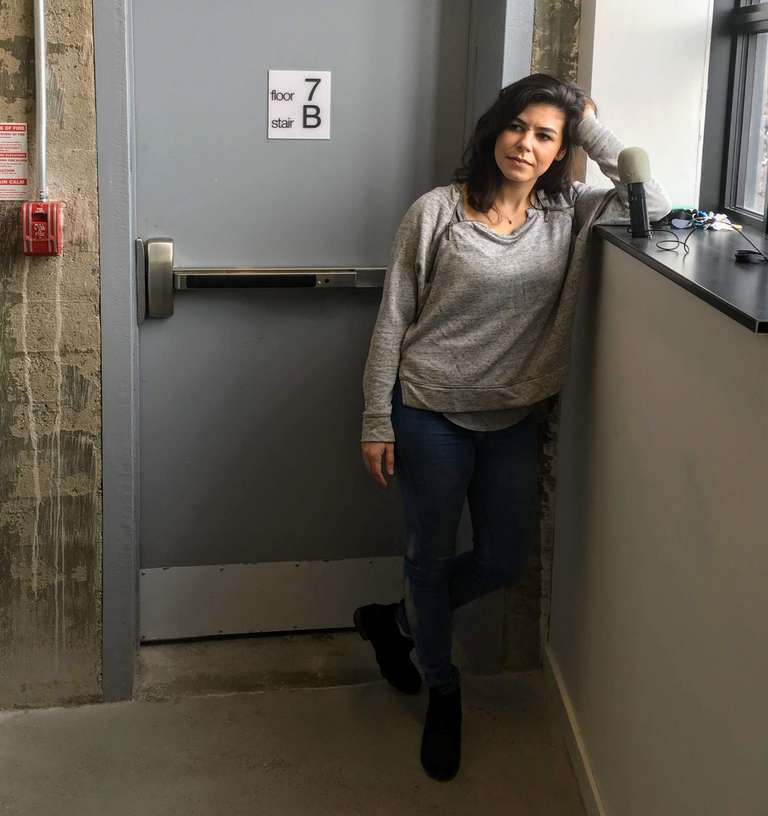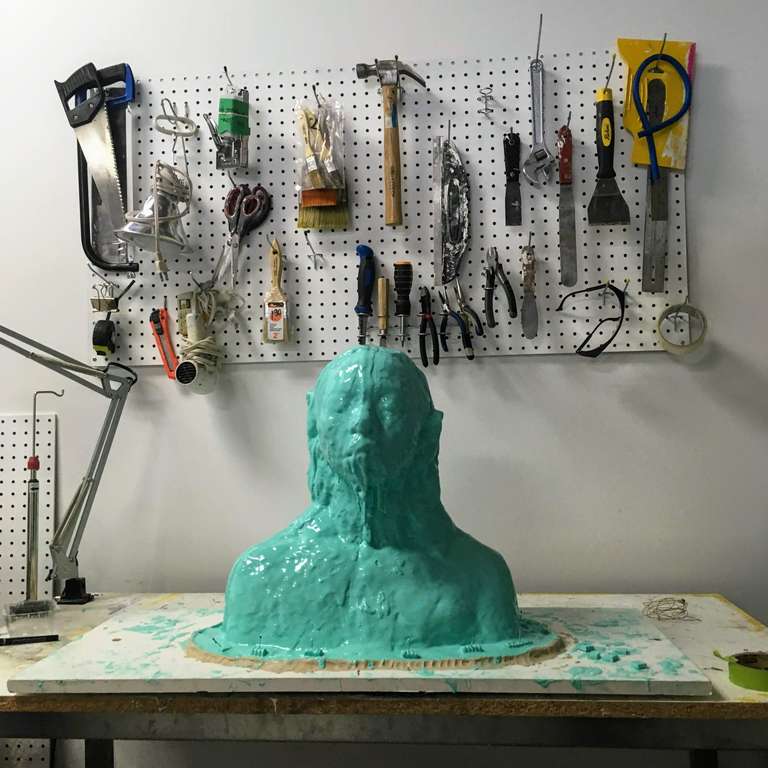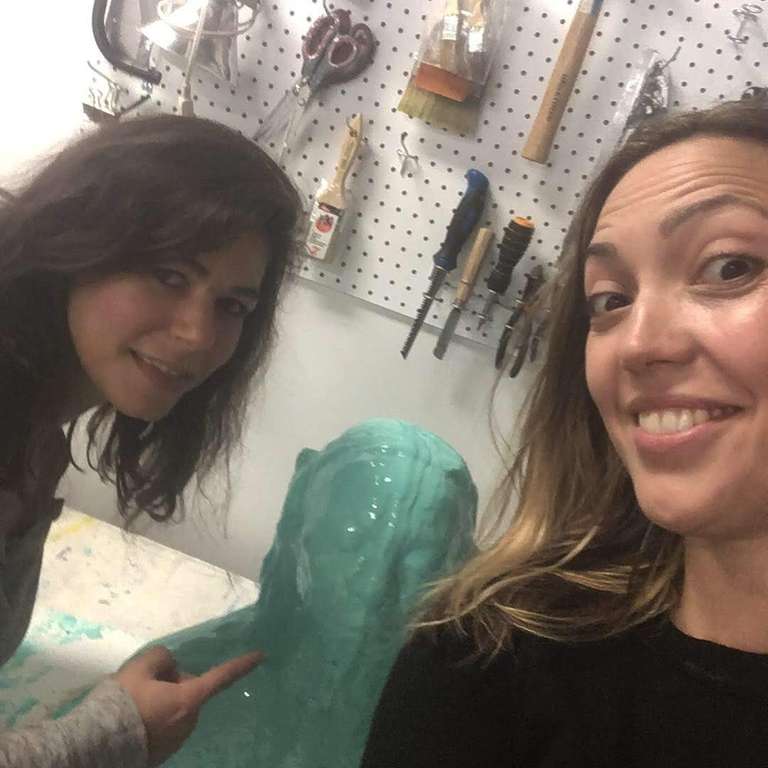How Samar Hejazi Avoids Getting Stuck in a Janitor's Closet

Get your boots and your coat, for this Canadian mischief. Join us as we desperately seek a quiet space to conduct an interview in Toronto’s Museum of Contemporary Art with Palestinian-Canadian artist Samar Hejazi. Hejazi is game for anything, which is probably why she’s so good at conceptual, installation, and sculptural arts. Hejazi is working on a commission that involved making a live cast of someone’s face, stitching onto dissolvable fabric (and then dissolving it), and making abstract marks for literally no reason at all. We are besotted.

Samar on Instagram: https://www.instagram.com/samarhejazi/?hl=en
Samar’s website: https://www.samarhejazi.com/
Akin, the arts organisation: https://www.akincollective.com/
Museum of Contemporary Art, Toronto: https://moca.ca/
Listen to the episode
Transcription of Samar Hejazi's interview
abbreviations
jb: Jozefien Buydens
sv: Svea Vikander
sh: Samar Hejazi
__
jb: Hello, hello, and welcome to Art Crush International. I'm Jozefien Buydens, a textile artist living very close to the beautiful North Sea.
sv: Well I'm Svea Vikander, a journalist, but I thought that I lived close to the North Sea
jb: Um, our coast looks over the North Sea
sv: Do we live on the same sea? That's so nice
jb: Oh my gosh, we are connected!
sv: I always knew it.
jb: In Art Crush International, we take you into the artist studios of the world because those places are just magic.
sv: And we do have a website, where you can see visuals of these things because currently you are listening to a podcast through your ear drums. So if you would like to see these things with your eyeballs, go to ACI.com, where you will see some images of the work we are talking about, and also some transcriptions of our episodes. Jozefien, tell me, who do we have a crush on this week?
jb: This week we have a crush on a Palestinian-Canadian artist who is based in Toronto, Samar Hejazi. So Samar makes these textile works, and she also works with words. So it's textile combined with words. And she's also a sculptor and she makes these beautiful sculptures of the human figure, it's not always a complete human figure. She does something very beautiful and poetic with it. If you go to her Instagram, which is actually just her name, it's Samar, S-A-M-A-R Hejazi, H-E-J-A-Z-I, there you can see that lately she's been taking a cast of somebody's bust. And you can follow the whole process of how that goes. And it looks like a lot of work.
sv: It really really does. So hopefully she'll share that with us.
jb: Yeah I hope so too.
sv: So should we go to Toronto?
jb: I think we should
sv: Do you have your bags packed? You got your passport?
jb: Got it all ready.
sv: Well we'll see.
jb: We'll see what happens here.
sv: OK everybody, hope you've got a nice winter coat packed, because we're going to Canada..
[music]
sh: Hi, my name is Samar Hejazi, I am an interdisciplinary artist based out of Toronto.
[traffic sounds]
sv: Just walking up to the Museum of Contemporary Art in Toronto, Ontario, Canada. It's in a restored industrial building in this district where I've been staying, which is right by the train tracks and full of warehouses and stuff. Super fun. I can see old loading doors that they've preserved behind glass. Beautiful old doors, nice, strong hinges. I'm going to go in to the lobby. Hi! Are you my artist?
Samar meets me in the lobby. There are person-sized foam blocks stacked all over the place. Part of an art installation. There are workers in hard hats running back and forth and Museum-looking people in nice clothes and name tags are running around, too.
[elevator sounds]
sv: So what floor is yours on?
sh: fourth
sv: fourth, ok.
She takes me to an elevator that is lined with a mustard-coloured blanket. I think there's a lot of people moving in and out of here today. We step out onto a floor with an open space and large windows where an exhibit seems to be in mid-install.
sh: So how do you know Oliver and uh...
sv: I know Oliver from U of T, like since second year of U of T.
sh: He went to U of T?
sv: We gossip about our mutual friends as we walk up to her studio.
sh: no, huh?
sv: No, I mean, he dressed really well.
Which, although it's in MOCA, is also part of the Akin Collective.
Is that sound, what's that sound?
Samar's space is the first on the left when you enter the Akin studio spaces. It's separated from the other studios by temporary dividers that go up about 6 feet of the maybe 14-foot ceiling
sh: So right now when you walk into my space, I have my cleaner work in the front, in these bins and the books and the papers and the desk is usually where I do the painting, and some computer stuff. Ideally I would have 2 desks, one for watercolours and 1 for computer things. Ideally I would have no computer things to do but that doesn't happen. It's 2018, so.
sv: About how big do you think your studio space is?
sh: I think it's 80 square feet, roughly? I wish it was twice this size [laughter]
sv: beyond the 2 desks stands a work table with a very goopy looking silicone human bust
sh: I have started working on a sculptural piece, it's a commission, based on my sculptures that I made a few years ago. So my older pieces have crystals that come out of the face or the head or whatever. So she saw a couple of those and wanted one of her own head, but with crystals coming out of her head. It relates to an experience that she had, a spiritual experience. So now I'm in the mould-making phase, so the sculpture's covered in silicone and then I'll cover this with plaster and then I'll open it up0, take out the clay, and then I'll cast it in plaster. And that's when I'll start playing around with the crystals, and breaking the piece and you know, sculpting. I did so much research to review my mold-making skills, I could write a PhD paper by the end of it. Like, "OK, go do it now, just go do it now!"
sv: And you also, you had to have her come in, right?
sh: Yeah, she came in, we did a life cast. That was... interesting.
sv: So you wouldn't wanna have to do that again.
sh: My gosh, no. That poor woman. I don't know if she would do that again.
sv: Really?
sh: Yeah, because she had to sit there for like 3 hours. And 3 hours with your mouth closed and your eyes closed, is fine when you have the silicone maybe, but when we started putting the plaster bandages on her head, it was heavy, you don't know what's going on, you can't talk, it's claustrophobic, you can't breathe that well, other than through your nose.
She said that she felt like she was like a mule or a plant that was under the earth and trying to get out, or like, she was being buried, so it was pretty dark. A little dark, yeah. But she does a lot of meditation, a lot of that kind of stuff, so she was OK. So yeah, so now my studio looks like a sculpting studio. And my sewing machines are put away.
sv: And now that this commission has come through…
sh: And now that I'm knees deep, hands deep, whatever
sv: elbows deep?
sh: Elbows deep
sv: She's a sculptor again, and an organised one.
sh: I know what I need. And so I just want what I need in front of me. And because I'm working with materials that have a curing time and I have to be calm while I'm making it, I can't be looking for a tool, or have the tool be dirty when I'm working. Just, less risk.
sv: I notice a sheet of paper with dozens of ordered black marks on it
sh: So I make very meditative pieces to help me connect with my body, or connect with my mind. So it'll be these repetitive marks in silence. Just line after line, small little marks in black oil stick, so they;re very dimensional. To me it's like I'm writing a letter and each mark is a word, so it's like mark mark mark, until the end of the line and then go down to the bottom and each one, even though you try to make it look like the one from before, or you're trying to keep a flow, they don't look the same and they never will.
And I think that's part of the beauty of it. I think it just makes me...still. Like I think this is one, these are moments where magic actually starts to happen because there's no pre-plan and there's no post-. There's no show and there's no planned outcome.
sv: And now the real adventure starts.
Let's scout out for a place that's very quiet
MOCA is a big place full of heating and ventilation ducts and it's in the middle of some major renovations
[saw sounds]
We walk to the top of a 5 storey stairwell,
Even here is quieter...
It is not quiet
[unintelligible voice on loud speakers]
We walk through a floor of experimental film screenings. Not quiet.
What's behind that door?
sh: Let's find out. I like this risk-taking
sv: Me too
So now we find ourselves facing a bank of anonymous grey doors. I try every handle.
Eventually one of them will... dammit. Wouldn't it be funny if we were locked in?
sh: It'd be like "I guess we're doing it here” [laughter]
sv: OK, 'Alarm Will Sound' it says over here. How is in here? This is probably the best we've had so far but I feel like we can do better.
Back out into the diegesis of experimental film and downstairs to the third floor alcove
sh: ...spot downstairs
sv: Yeah? OK yeah let's try it [giggling]
We see one of those museum-looking people and do what we probably should have done a long time ago, which is: ask a person who might know
sh: So we're looking for a really quiet spot to record an interview
sv: Is there an office?
But she doesn't. We have to find someone with more power.
sh: So do you wanna try to talk to Harshida?
sv: So where is Harshida now?
sh: She went down to the second floor
sv: And now I really don't know what happened. Because talking to Harshida was a good and reasonable plan but... now we're opening a door, we're going down some very dusty old stairs and now we're in the basement.
sv: [whispering] Oh! Look at the old work here.
There's a tiny, low-ceilinged doorless room off of the stairs, like maybe they used to store ice blocks down there or something. It's so cute and weird but...
sh: Is it echoey?
sv: A little. Yeah. Too bad.
Now we're like running loose in the bowels of Canadian Contemporary Art, opening all the doors, seeing all the graffiti and bricks from before, when this was a factory. We find the laundry, the walk-in freezers, the old posters and tote bags. Boxes of food. everything you need to make a museum go, except for a place where an artist could be interviewed. And then, look! It's a janitor's closet. An unlocked janitor's closet.
I mean, are you comfortable? Let me um, I'll test the audio. But let me, we can close this door.. right?
sh: Yeah, I mean
sv: They'll knock, right
sh: We'll just apologize if we did something wrong.
sv: I'm about to close the door but Samar has a better idea.
She'll stand outside and I'll stand inside, just to make sure the door will reopen. I'm so glad that one of us is thinking.
I'm happy to sit on the floor. Let's move this in front of you, [metal scraping]
Despite Samar's very valiant willingness to crouch down in the middle of a janitor's closet to be interviewed, it's echoey. So, we go back to our alcove by the stairs, above ground. Looking out the window, like normal people.
[saw sounds]
sv: Yeah so beautiful, we'll make good radio.
sh: I used to take a lot of art classes in high school but I wasn't really "allowed" to be an artist. I went to architecture school at Ryerson. I did three years of that. Realised I needed to do 7 years to graduate and be an architect-architect and I didn't love it and I didn't have a passion for it.
Dropped out and switched into new media, It's a BA of Fine Arts. But I still had the excuse of, I can be a designer or a web designer. And then by my 4th year, my thesis year, I was making installation art. And I had joined a sculpting studio. So I kind of fell into art-making and I gave in.
And one of my profs in 3rd year, when he saw two of my projects he said, "I'm gonna ignore all the crap that you were doing all year and I'm just gonna give you an A for the year and you're gonna keep making art like this and you're going to do a year of art-making after university. And then you're gonna do your master's in fine arts and that's just what you're gonna be doing."
And so I guess that's when I was like, 'I guess I'm just gonna be an artist because I happen to just always fall into this, you know?' Yeah so I graduated, I didn't end up doing my master's like he told me to. I started doing sculpture and that work was based on my relationship with the spiritual world.
And then after that I wanted to do work that was more cultural. I think most of my work is about layers of identity and how I relate to those layers of identity. Originally, I am Palestinian. My grandmother runs a Palestinian heritage centre in Jordan. So we always had embroidery around us, traditional embroidery and very traditional things, always. Women's crafts and stuff like that.
So I started to do embroidery. Just to try to connect. And I did an instructional residency in Mexico and then I went to Berlin for three months for another residency, to develop the concept a little further. And then I went to Palestine and Jordan and then after that I started working with textiles. So, floating textiles and traditional embroidery practices and trying to push them into contemporary art.
sv: What does your grandmother think of your art practice?
sh: She loves it. A lot of it is a little confusing. But a lot of it she just gets. She gets me.
sv: Ah, is she an artist?
sh: No. No. Maybe. Like, she has taste but I don't think she's ever explored the idea of being an artist. That just wasn't an option. She's more entrepreneurial as opposed to businessy, and I think my work is very conceptual. So for a lot of them it's like, "Why did you do that? It's so nice without you doing that." I have a piece, I did the embroidery and then I cut the embroidery so it's like fluffy and to them it's ruined. But to me it symbolises the abstraction of tradition. And it talks about how now culture and tradition is being used as a way to lure people in, as a novelty, for tourism. But the truth of the traditions and the cultures and the rituals aren't explored as deeply as they used to be. So it's just an abstraction of what these things used to be.
[music]
sh: I think people like to make up stories about my work. Your experience of my work is your experience. But I think what they get wrong is when I say I'm Palestinian or I'm Canadian and you know, emigrated, and they always think that there's a sense of victimhood.
And it's like, No it's not, I'm privileged, like, I wasn't kicked out, we came on our own. I'm not a refugee. I'm just telling a story of who I am. I think sharing what is is harder than sharing a story that is already embedded with so much drama. I'm trying to stay pure to my narrative.
I make jokes when people give me ideas of what to make in my art. I'm like, "I'm gonna start a group chat with you guys and you can just list all your ideas on that chat and then when I have a creative block, I'll check in, but until then…"
sv: That's a great idea! Have you done that yet?
sh: No I haven't. but it's like that would be an art piece in and of itself.
[music]
sv: In terms of your studio space, can you talk about how long you've been at Akin and how long it's been?
sh: I've been with Akin for four years. Akin is an organisation that provides studio spaces for artists. So it becomes a collective of artists working side by side. And obviously that in turn becomes a community of artists. Akin facilitates that but also has different events that they organise for us, and for others. And show-and-tells and just lots of opportunities to flourish as an artist. I love Akin. I think Akin is a great community. Like they really take care of their artists. When you get evicted, they'll find another place for all of us to stay together. They understand the importance.
sv: And so, did Akin ask you to do this residency? Or did you apply?
sh: I applied. There was a proposal.
sv: What did you pitch in your proposal?
sh: I was just telling them what I was working on. I was working on an installation piece that, again, was about identity. So I sewed onto a fabric that dissolves and I dissolved it at the studio and all the things that I sewed held together because they were connected. And so it's floating.
I hung it from the ceiling. And there's no fabric holding the threads, so it's just the threads.
sv: And is that the one you did with some text? Like, a song?
sh: So it's a song called “Homeland", it's a Palestinian song, and now it's the Iraqi anthem and it's about loss of land and all of that. And my grandmother used to sing it to us. So I wrote it out in this English-Arabic. When Arabs that are living in the West communicate with Arabs in the East, they'll use the Latin alphabet. So for the sounds that the English alphabet doesn't have, we'll use numbers to make the sound.
sv: And is this because the script is hard to learn?
sh: I think it just kind of happened in the '90s with ICQ and MSM Messenger, when all those platforms came up. And not all the keyboards had an Arabic option and everything was in English but we were still trying to speak in Arabic sometimes. And so, I thought that was a pretty amazing phenomenon. And I was surprised, nobody talks about it! I mean, even the Arabs don't talk about it. It's part of an identity that forms.
[music]
sv: So what do you like about the studio space?
sh: I like the professionalism of the artists around me. Everybody who's at these studios is serious about their career. They show up and they think deeply about what they're doing. And they're committed and they dream big.
Yeah, I think it's important who you have around. It's such a crazy career to go into. I don't know what next month is gonna look like, both financially and creatively. But you just kind of have to have this faith and a commitment to yourself and...
sv: So how does having these other professional artists around, how does that help you?
sh: There isn't as much helplessness or hopelessness. Being around other people that are achieving, it kind of gives you hope.
sv: So if you could change one thing about your studio at Akin, what would that be?
sh: I wish my space was more square. My work is three dimensional now so it would be nice to walk around my pieces and have my pedestal in the middle. I think I would like to have a second wall instead of the curtain wall that we found to delineate me and Eva. But we can't drill into the floor so that;'s why we couldn't put up walls. And I wish I had a window.
But whatever, once I start working I don't think about it. It's usually in between. I would love to have a clean section for the painting and then a sculpting section and a little couch for embroidery...
sv: In your day-to-day life, do you have another way of supporting yourself?
sh: I teach art to kids on the weekend. And that's all.
sv: And has the government of Canada given you any funding?
sh: Yes, I just got a grant from the Canadian government. And I got an exhibition assistance grant from the TO arts council. So, yeah, they help. It's great. One of the biggest benefits of being here.
[music]
sh: You can see my work at www.samarhejazi.com. Or on Instagram, at samarhejazi.
sv: That was so much fun to have you guys with me there in Toronto. Jozefien, um, did you not make it?
jb: No, I guess there was something wrong with my…luggage.
sv: Did you go to Hawaii instead of Canada?
jb: I think I did. It was just too cold for me.
sv: I see, so that's why I'm frostbitten and you have a tan. Excellent, perfect, good. So what do we have on next for the show today?
jb: It's the beautiful online thing! I found a beautiful website which is called beleefdenachtwacht.nl
sv: [laughter] “beleef de nachtwacht?”
jb: You say that beautifully Svea. So translated in English this means 'Experience the Nightwatch' and this is a very famous painting by the Dutch painter Rembrandt.
[see the BOT at www.beleefdenachtwacht.nl]
jb: And our crush next week is Angela Hennessy
sv: Ugh I love her and I love visiting her studio, too.
jb: Yes me too. She is a wonderful artist who works with hair and death and blackness. You can see her work at houseofhennessy on Instagram.
sv: And that's our show for the day. Remember to subscribe and give us a review if you like us
jb: And if you would like to hear more of us in some personal letters that get into your inbox, subscribe to our newsletter on our website, artcrushinternational.com
sv: We would love to join you in your inbox
[laughter]
jb: Great
sv: Bye! Thanks for listening, bye bye bye.




